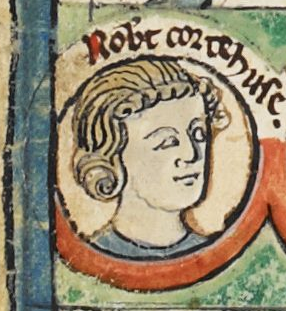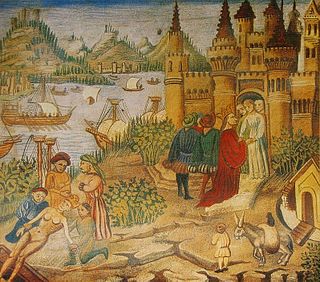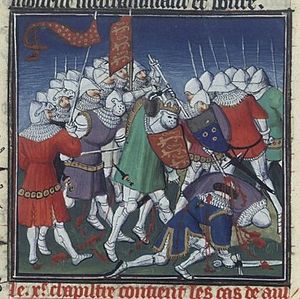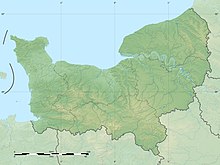
Robert Curthose, was the eldest son of William the Conqueror and succeeded his father as Robert II of Normandy in 1087, reigning until 1106.

Odo of Bayeux was Bishop of Bayeux in Normandy, and was also made Earl of Kent in England following the Norman Conquest. He was the maternal half-brother of duke, and later king, William the Conqueror, and was, for a time, William's primary administrator in the Kingdom of England, although he was eventually tried for defrauding the William's government. It is likely Odo commissioned the Bayeux Tapestry, a large tableau of the Norman Conquest, perhaps to present to his brother William. He later fell out with his brother over Odo's support for military adventures in Italy. William, on his deathbed, freed Odo. Odo died in Palermo Sicily on the way to crusade.

William Clito was a member of the House of Normandy who ruled the County of Flanders from 1127 until his death and unsuccessfully claimed the Duchy of Normandy. As the son of Robert Curthose, the eldest son of William the Conqueror, William Clito was seen as a candidate to succeed his uncle King Henry I of England. Henry viewed him as a rival, however, and William allied himself with King Louis VI of France. Louis installed him as the new count of Flanders upon the assassination of Charles the Good, but the Flemings soon revolted and William died in the struggle against another claimant to Flanders, Thierry of Alsace.

Robert, Count of Mortain, first Earl of Cornwall of 2nd creation was a Norman nobleman and the half-brother of King William the Conqueror. He was one of the very few proven companions of William the Conqueror at the Battle of Hastings and as recorded in the Domesday Book of 1086 was one of the greatest landholders in his half-brother's new Kingdom of England.
Robert de Bellême, seigneur de Bellême, seigneur de Montgomery, viscount of the Hiémois, 3rd Earl of Shrewsbury and Count of Ponthieu, was an Anglo-Norman nobleman, and one of the most prominent figures in the competition for the succession to England and Normandy between the sons of William the Conqueror. He was a member of the powerful House of Bellême.

William de Warenne, 2nd Earl of Surrey was the son of William de Warenne, 1st Earl of Surrey and his first wife Gundred. He was more often referred to as Earl Warenne or Earl of Warenne than as Earl of Surrey.

William III of Ponthieu also called William Talvas. He was seigneur de Montgomery in Normandy and Count of Ponthieu.

The House of Normandy was a noble family originating from the Duchy of Normandy. The House of Normandy's lineage began with the Scandinavian Rollo who founded the Duchy of Normandy in 911.
William of Mortain was Count of Mortain and the second Earl of Cornwall of 2nd creation.

Helias of Saint Saëns (?–1128), Count of Arques was a Norman magnate of the eleventh and twelfth century, a loyal supporter of Robert Curthose and protector of his son William Clito. His support of the latter eventually brought him into conflict with Henry I of England, ending in his willing exile from Normandy.

Elias I, called de la Flèche or de Baugency, was the Count of Maine, succeeding his cousin Hugh V, Count of Maine.
Events from the 1100s in England.
Ranulf le Meschin, 3rd Earl of Chester (1070–1129) was a Norman magnate based in northern and central England. Originating in Bessin in Normandy, Ranulf made his career in England thanks to his kinship with Hugh d'Avranches - the Earl of Chester, the patronage of kings William II Rufus and Henry I Beauclerc, and his marriage to Lucy, heiress of the Bolingbroke-Spalding estates in Lincolnshire.

Sibylla of Conversano was a wealthy Norman heiress, Duchess of Normandy by marriage to Robert Curthose. She was regent of Normandy during the absence of her spouse.
Ralph of Gacé was a member of the House of Normandy who played an influential role during the minority of William the Bastard, prior to his conquest of England. Ralph was the lord of Gacé and other estates in Normandy.
William of Évreux or William d'Évreux was a member of the House of Normandy who played an influential role during the Norman conquest of England, one of the few Norman aristocrats documented to have been with William I at Hastings. He was the count of Évreux in Normandy as well as additional lands and expanded his holdings by consenting to the marriage of his young ward and niece Bertrade to Fulk the Rude of Anjou, whose support against the Manceaux rebels was important for William's liege Robert Curthose. A feud between William's wife Helvise or Heloise of Nevers and Isabel of Conches, the wife of Raoul II of Tosny, led to open war between the two men. Helvise also governed Évreux in William's infirm old age until her own death. Having no children of his own, William was succeeded at Évreux by his sister's son Amaury of Montfort.
Events during the year 1103 in Italy.
Robert, Count of Eu and Lord of Hastings, son of William I, Count of Eu, and his wife Lesceline. Count of Eu and Lord of Hastings.
The army of Robert Curthose, Duke of Normandy, left for the Holy Land on the First Crusade. Robert was the eldest son of William the Conqueror and brother to William Rufus, king of England. He was reportedly so poor that he often had to stay in bed for lack of clothes. In order to raise money for the crusade he mortgaged his duchy to his brother William II of England. His army joined the contingent of Robert II, Count of Flanders, and Stephen, Count of Blois.

The Montgomery family or de Montgomerie is a prominent family of Anglo-Norman origin, belonging to both French and British nobility. At the turn of the 12th century, the family was one of the leading families, with Robert de Bellême being the wealthiest and most powerful magnate in England and Normandy. The House was succeeded by the House of Belleme.












